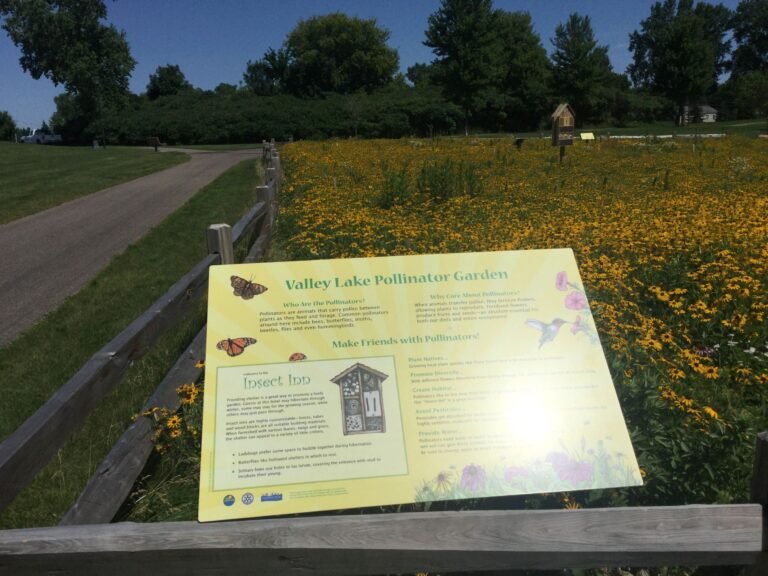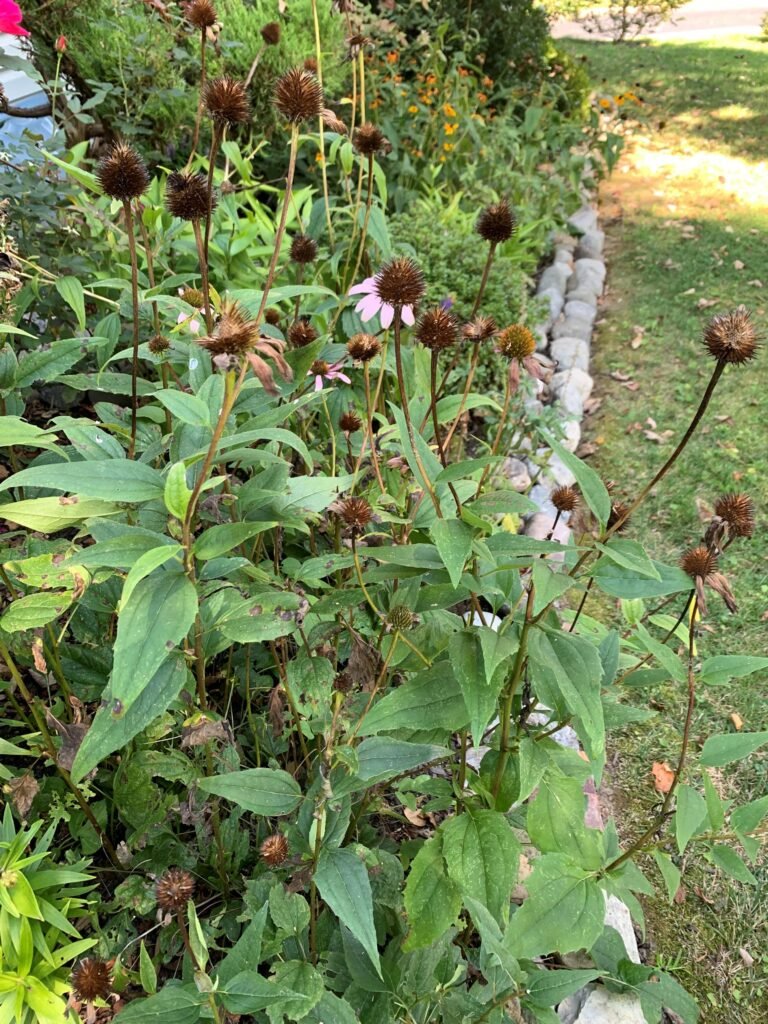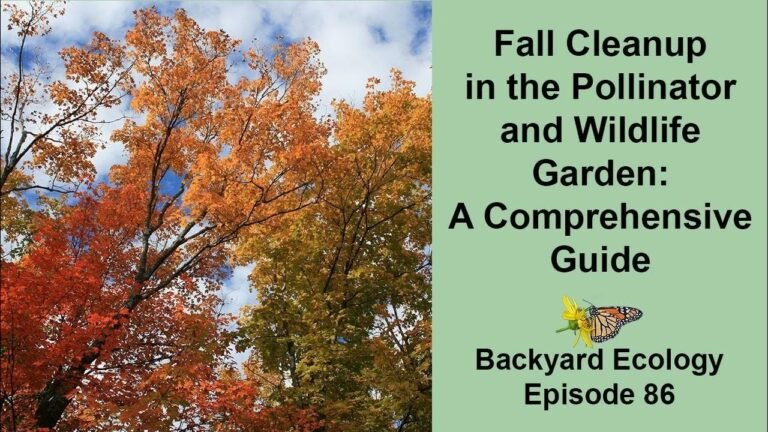Pollinators play a crucial role in our ecosystem. They help plants grow, breed, and produce food.
As fall approaches, it’s important to support these vital creatures. During the fall season, pollinators like bees, butterflies, and hummingbirds need extra care. The changing weather can make it harder for them to find food and shelter. By taking small steps, you can create a welcoming environment for these essential insects and birds.
Whether you have a big garden or just a balcony, there are ways to help. This blog will explore ten simple and effective methods to support pollinators during the fall. These tips will ensure they thrive and continue their vital work in nature. Let’s dive in and make a difference together!
Plant Fall-blooming Flowers
Fall is a crucial time to support pollinators. As the seasons change, many flowers die off, leaving pollinators with fewer resources. By planting fall-blooming flowers, you can provide essential nectar and pollen for bees, butterflies, and other pollinators. This can help them prepare for winter or migration.
Best Flower Choices
| Flower | Blooming Period | Pollinator Preference |
|---|---|---|
| Asters | Late summer to fall | Bees and butterflies |
| Goldenrod | Late summer to fall | Bees and butterflies |
| Sunflowers | Late summer to fall | Bees |
| Sedum | Late summer to fall | Bees and butterflies |
| Joe-Pye Weed | Late summer to fall | Butterflies |
Planting Tips
- Choose the right spot: Most fall-blooming flowers need full sun. Ensure they get at least six hours of sunlight each day.
- Prepare the soil: Use well-draining soil. Add compost to enrich the soil and improve drainage.
- Water wisely: Water your new plants regularly. Keep the soil moist but not waterlogged.
- Mulch: Apply a layer of mulch around your plants. This helps retain moisture and suppress weeds.
- Deadhead: Remove spent flowers to encourage more blooms. This keeps the plants looking tidy.
Planting fall-blooming flowers not only beautifies your garden. It also provides crucial support for pollinators during a critical time.
Avoid Pesticides
Fall is a critical time for pollinators. They need support to survive winter. One important way to help is to avoid pesticides. These chemicals can harm bees, butterflies, and other pollinators. Choosing safer options benefits your garden and the environment.
Pesticide Alternatives
Consider natural pest control methods. Neem oil is a popular choice. It repels pests without harming pollinators. Insecticidal soap is another safe option. It targets harmful insects but spares the beneficial ones. Diatomaceous earth can also be effective. This powder kills pests by dehydrating them.
Safe Pest Control
Introduce beneficial insects to your garden. Ladybugs and lacewings eat harmful pests. Attract birds. They can help control insect populations. Use barriers like row covers to protect plants. These prevent pests from reaching your crops. Mulching can also deter pests. It keeps the soil moist and reduces weeds.
By avoiding pesticides and using safer methods, you support pollinators. Your garden will thrive, and so will the environment.
Create Habitat Shelters
Creating habitat shelters for pollinators is crucial in the fall season. As the weather cools, pollinators need safe places to rest and hibernate. Simple efforts in your garden can make a big difference. Let’s explore some effective ways to create these shelters.
Building Bee Hotels
Bee hotels provide essential nesting sites for solitary bees. These bees do not live in hives. Instead, they seek out small holes or cavities to lay their eggs. You can build a bee hotel with natural materials. Use bamboo tubes, wooden blocks, or drilled logs. Place these materials in a sheltered, sunny spot in your garden. This will attract bees and give them a safe place to nest.
Creating Butterfly Havens
Butterflies need special areas to thrive in the fall. Creating a butterfly haven involves planting the right plants. Choose nectar-rich flowers like asters and goldenrods. These flowers provide food for adult butterflies. Also, include host plants for caterpillars. Milkweed is an excellent choice. It supports the entire lifecycle of monarch butterflies. Add some flat stones in sunny spots. Butterflies love to bask in the sun on these stones. A small, shallow water source will also help. Butterflies need water to drink and stay hydrated.
Leave Leaf Litter
Supporting pollinators in the fall season is crucial. One of the top ways to help is to leave leaf litter. Fallen leaves provide essential habitats for many pollinators. They offer shelter and food, ensuring pollinators survive through the winter.
Benefits Of Leaf Litter
Leaf litter plays a significant role in the ecosystem. It creates a natural habitat for insects and small animals. Many pollinators, like butterflies and bees, use leaf litter to hibernate.
- Protection: Leaves protect pollinators from the cold.
- Food Source: Decaying leaves provide nutrients for insects.
- Soil Health: Leaves decompose and enrich the soil.
These benefits make leaving leaf litter an easy way to support pollinators. It creates a thriving environment for many species.
Effective Leaf Management
Managing leaf litter effectively can maximize its benefits. Here are some tips:
- Create Leaf Piles: Gather leaves into small piles. These piles provide concentrated habitats for pollinators.
- Avoid Leaf Blowers: Leaf blowers disturb natural habitats. Use a rake instead to minimize disruption.
- Use Leaves as Mulch: Spread leaves in garden beds. They act as natural mulch, retaining moisture and suppressing weeds.
Effective leaf management not only helps pollinators but also improves garden health. It’s a win-win for your garden and the environment.
| Action | Benefit |
|---|---|
| Create Leaf Piles | Provides habitats |
| Avoid Leaf Blowers | Minimizes disturbance |
| Use Leaves as Mulch | Improves soil health |
By leaving leaf litter, you support pollinators and enhance your garden. These simple actions create a healthier environment for all.
Provide Fresh Water
Pollinators such as bees, butterflies, and birds need fresh water to thrive, especially in the fall season. By providing clean water sources, you can help these vital creatures stay hydrated and healthy. Below are some practical ways to support pollinators by offering fresh water during the fall season.
Setting Up Water Stations
Creating water stations for pollinators is simple and effective. You can use shallow dishes, birdbaths, or even repurpose old plates.
Consider placing stones or marbles in the water to give bees and butterflies a safe landing spot. This prevents them from drowning while drinking.
Place the water stations in shady areas to keep the water cool and minimize evaporation. Pollinators will appreciate accessible water in their habitats.
Maintaining Clean Water
Keeping the water clean is crucial for the health of pollinators. Change the water every two days to prevent algae growth and mosquito breeding.
Scrub the containers with a brush to remove any dirt or debris. Use a mild soap if necessary, but rinse thoroughly to avoid harmful residues.
During colder months, consider using a heated birdbath to ensure water remains liquid and accessible. Pollinators will have a reliable water source even in chilly weather.
| Tip | Action |
|---|---|
| Shallow Dishes | Use plates with stones or marbles |
| Shady Areas | Place water stations away from direct sunlight |
| Clean Regularly | Change water every two days |
Grow Native Plants
Supporting pollinators in the fall season can make a big difference. One of the best ways to do this is by growing native plants. Native plants provide food and shelter for pollinators. They are well-suited to the local climate and soil. This makes them easy to grow and maintain.
Choosing Native Species
Choosing the right native species is important. First, research which plants are native to your area. You can find this information online or at local nurseries. Native plants vary depending on your region. Make a list of the plants that are native to your area.
- Check if the plant supports local pollinators.
- Consider the plant’s blooming season.
- Choose plants that bloom at different times.
This will ensure a steady food supply for pollinators throughout the season.
Plant Care Tips
Caring for native plants is simple. Follow these tips to keep your plants healthy:
- Water the plants regularly, especially in dry periods.
- Mulch around the base of the plants to retain moisture.
- Remove any weeds that compete for nutrients.
Native plants are adapted to your local environment. They require less fertilizer and pesticides. This makes them environmentally friendly and safe for pollinators.
By growing native plants, you support local pollinators. You also create a beautiful and sustainable garden. So, start planting native species today and watch your garden thrive!
Reduce Lawn Area
Reducing lawn area is a simple yet impactful way to support pollinators in the fall season. Lawns offer little to no food or habitat for pollinators. By reducing the size of your lawn, you can make space for plants that provide nectar and pollen. This change not only benefits pollinators but also reduces your lawn maintenance efforts.
Benefits Of Smaller Lawns
Smaller lawns come with numerous benefits. Here are some key advantages:
- Less maintenance: Smaller lawns require less mowing, watering, and fertilizing.
- Water conservation: Lawns are water-intensive. Reducing lawn area saves water.
- Cost savings: Lower maintenance means reduced costs on lawn care products and services.
- Environmental impact: Reduced use of fertilizers and pesticides benefits the environment.
- Increased biodiversity: More space for native plants increases local biodiversity.
Alternatives To Grass
Consider these alternatives to traditional grass lawns:
- Wildflower meadows: Planting wildflowers provides food and habitat for pollinators.
- Native plants: Native plants are adapted to the local climate and support local wildlife.
- Ground covers: Use ground covers like clover or creeping thyme. These require less water and maintenance.
- Herb gardens: Herbs such as lavender, mint, and rosemary attract pollinators and are useful in the kitchen.
- Vegetable gardens: Growing vegetables can provide food for both humans and pollinators.
By reducing your lawn area and incorporating these alternatives, you create a supportive environment for pollinators. Your garden becomes a haven for bees, butterflies, and other beneficial insects. It’s a win-win for you and the ecosystem.
Support Local Pollinator Initiatives
Supporting local pollinator initiatives is essential for maintaining healthy ecosystems. Pollinators like bees, butterflies, and birds play a crucial role in plant reproduction. They help our gardens and crops thrive. Supporting these initiatives can make a significant difference.
Joining Community Projects
Many communities have projects that support pollinators. These projects may include planting native flowers, creating pollinator gardens, or maintaining habitats. By joining these projects, you can directly contribute to a healthier environment. You also get to meet like-minded individuals who care about nature.
Local parks often organize events where volunteers can help plant flowers. Schools and community centers may also have programs dedicated to teaching about pollinators. Participating in these activities is a fun way to learn and contribute. Your involvement can inspire others to join, amplifying the impact.
Donating To Pollinator Programs
If you cannot join in person, consider donating to pollinator programs. Many organizations rely on donations to fund their efforts. These funds go towards planting, research, and educational programs. Even a small donation can make a big difference.
Look for local or national organizations dedicated to pollinator conservation. Websites often have sections where you can donate online. Your financial support helps ensure these programs continue to thrive. Donations can also be used to purchase supplies needed for various projects.
Supporting pollinator programs financially can be as impactful as volunteering. Every contribution counts, no matter the size. By donating, you help create a sustainable future for pollinators and the environment.
Educate Others
One of the most impactful ways to support pollinators in the fall is to educate others. Sharing knowledge can create a ripple effect that benefits the environment. Below, we explore two effective methods to spread awareness: hosting workshops and sharing resources.
Hosting Workshops
Hosting workshops is a powerful way to educate your community. You can invite local experts or experienced gardeners to speak. This creates a learning environment where people can ask questions and gain practical advice.
Topics for workshops could include planting fall flowers, creating pollinator habitats, and understanding the lifecycle of pollinators. Having hands-on activities, such as planting sessions, can make the workshops more engaging.
Here is a simple outline for a workshop:
| Time | Activity |
|---|---|
| 10:00 AM | Introduction and Welcome |
| 10:15 AM | Guest Speaker Presentation |
| 11:00 AM | Hands-on Planting Session |
| 12:00 PM | Q&A and Closing Remarks |
Sharing Resources
Sharing resources can help others learn more about supporting pollinators. You can distribute brochures, pamphlets, or online resources. These should include practical tips and actionable steps.
Use social media to share articles, videos, and infographics. Create a community page where people can share their experiences and ask for advice. This fosters a sense of community and shared purpose.
You can also create a resource list with links to reliable websites and books. Here’s an example:
- Pollinator Partnership – Resource for pollinator conservation
- Xerces Society – Information on pollinator protection
- Penn State Extension – Guides on gardening for pollinators
By sharing resources, you empower others to take action. This collective effort can make a significant impact on pollinator health.
Monitor And Record Pollinators
Monitoring and recording pollinators in the fall season can greatly help in understanding their habits and needs. By tracking their activities and contributing to citizen science projects, you can provide valuable data that supports their survival. This not only aids in conservation efforts but also connects you with nature in a meaningful way.
Tracking Pollinator Activity
Keep a journal to note the types of pollinators you see. Record the dates and times of their visits. Include details about the plants they frequent. Observing their patterns helps in identifying their peak activity periods.
Use a camera to capture images of the pollinators. This can help with identifying different species. Photos also serve as a visual record. They can be shared with experts for further analysis. This practice can improve your observation skills and deepen your understanding of pollinator behavior.
Contributing To Citizen Science
Join citizen science projects that focus on pollinators. Many organizations collect data from volunteers. Your observations can contribute to these databases. This collective effort helps scientists track pollinator populations. It also aids in identifying trends and potential threats.
Share your findings with local conservation groups. They may use your data to enhance their efforts. This can lead to better protection strategies for pollinators. Being part of a larger community can also be rewarding. It provides an opportunity to learn from others and share your experiences.
Frequently Asked Questions
How Can I Help Pollinators In The Fall?
Plant late-blooming flowers and provide water sources. Leave fallen leaves and avoid pesticides to create a pollinator-friendly habitat.
Why Are Fall Flowers Important For Pollinators?
Fall flowers provide essential nectar and pollen. They help pollinators build up energy reserves for migration or hibernation.
What Types Of Plants Attract Fall Pollinators?
Plants like asters, goldenrod, and sedum attract pollinators. These plants provide nectar and pollen in the fall season.
Should I Leave Fallen Leaves For Pollinators?
Yes, fallen leaves offer shelter and overwintering sites. They create a natural habitat for pollinators and other beneficial insects.
Conclusion
Supporting pollinators in the fall is vital for our ecosystem. Simple actions like planting native flowers make a big difference. Avoid using pesticides to keep pollinators safe. Provide water sources for them to drink. Create habitats by leaving some garden debris.
Each effort helps sustain pollinator populations. Your garden can thrive with their help. Start today and see the positive impact. Every small step counts. Together, we can create a pollinator-friendly environment. Your contribution matters. Let’s protect these essential creatures.



